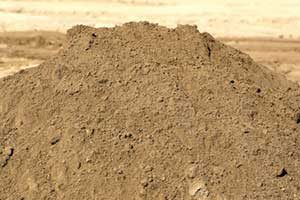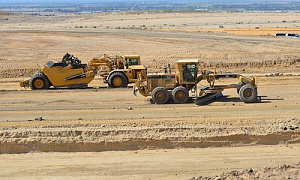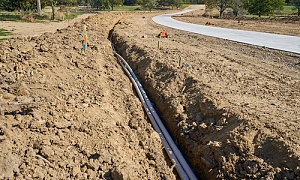Fill dirt is a critical component in many construction and landscaping projects. This type of dirt, located below the topsoil layer, has a composition distinct from that of topsoil. It consists primarily of hard, rocky material and lacks the organic compounds and nutrients found in topsoil. Because of its unique properties, fill dirt has various uses that other types of dirt are not suitable for.
Composition and Characteristics of Fill Dirt

Fill dirt is essentially subsoil that has been excavated from beneath the nutrient-rich topsoil layer. Unlike topsoil, which is rich in organic matter and nutrients, fill dirt is composed mostly of inorganic materials like sand, clay, and small rocks.
The absence of organic matter is a crucial characteristic that makes fill dirt stable and resistant to settling. Organic matter decomposes over time, creating air pockets and causing the soil to shift. This is not an issue with fill dirt, making it an ideal material for projects that require stability.
Practical Uses of Fill Dirt
Due to its stable nature, fill dirt is used in various construction and landscaping projects. Here are some of its primary applications:
Structure Foundation
Fill dirt is essential for creating a stable foundation for structures. If the land around your home has natural depressions or uneven terrain, fill dirt can level it out. When building new structures or extensions, structural fill dirt—screened and tested to ensure the absence of organic material—is recommended. This type of fill dirt provides a solid base that supports the weight of buildings and prevents shifting over time.
Grading and Sloping
Proper grading and sloping of land around your home are vital for effective drainage. Older homes often have level or improperly sloped surrounding land, which can lead to water pooling and foundation damage. Fill dirt can be used to create a slope that directs water away from the house, dropping at least two or three inches every ten feet. This prevents water damage and ensures the longevity of your home’s foundation.
Site Preparation
Before constructing new buildings, site preparation is necessary. This process includes demolishing existing structures, clearing away trees, and removing other obstacles. Fill dirt is used to fill gaps or holes left behind during the clearing or demolition process, creating a level surface for new construction.
Ditches
Fill dirt is also useful for managing ditches. It can be used to raise the level of an existing ditch to improve drainage or to fill a ditch that is no longer needed. However, it is important to consult local authorities before filling a ditch to ensure compliance with regulations.
Drainage Pathways

Creating drainage pathways is another application of fill dirt. Proper drainage pathways improve the flow of water from rainfall or other sources, preventing water accumulation around your home. Fill dirt helps direct water flow efficiently, protecting your property from water damage.
Man-Made Hills
For both aesthetic and practical purposes, fill dirt can be used to create man-made hills or landscape mounds. These mounds can enhance garden design by raising plants to higher levels, providing a unique visual appeal. Additionally, man-made hills offer greater privacy for homeowners in densely populated areas. When constructing these hills, it is essential to use fill dirt for the lower portion and topsoil for the upper portion, ensuring the mound can support plant life.
Estimating the Amount of Fill Dirt Needed
When planning a project that requires fill dirt, it is important to accurately estimate the amount needed. Dirt is typically sold by the cubic yard, with one cubic yard equaling 27 cubic feet (a cube measuring one yard on each side). To determine the amount of fill dirt required, you need to calculate the volume of the area to be filled in cubic yards.
Here’s a simple way to estimate:
- Measure the Area: Determine the length, width, and depth of the area you need to fill.
- Calculate the Volume: Multiply the length, width, and depth measurements to get the total volume in cubic feet.
- Convert to Cubic Yards: Divide the total cubic feet by 27 to convert to cubic yards.
For example, if you have an area that is 10 feet long, 5 feet wide, and 2 feet deep, the calculation would be:
- Volume in cubic feet = 10 x 5 x 2 = 100 cubic feet
- Volume in cubic yards = 100 / 27 ≈ 3.7 cubic yards
Acquiring Fill Dirt

Fill dirt can be purchased from landscaping suppliers, construction companies, or directly from excavation sites. In some areas, you may be able to obtain fill dirt
for free, especially if there is ongoing construction or excavation work nearby. However, it is important to ensure that the fill dirt you acquire is clean and free from contami
nants.
Get in Touch with Northern Virginia’s Top Fill Dirt Experts
Fill dirt is an essential resource for construction and landscaping projects that require a stable, non-settling material. Its unique composition, free from organic matter, makes it ideal for creating solid foundations, grading land, and preparing sites. By understanding the proper uses and estimation of fill dirt, homeowners and builders can effectively enhance and protect their properties.
Whether you need to level a yard, build a new structure, or create a man-made hill, fill dirt offers the stability and support needed for successful project completion. Contact Northern Virginia’s top fill dirt experts at Dirt Connections today to get started!








































